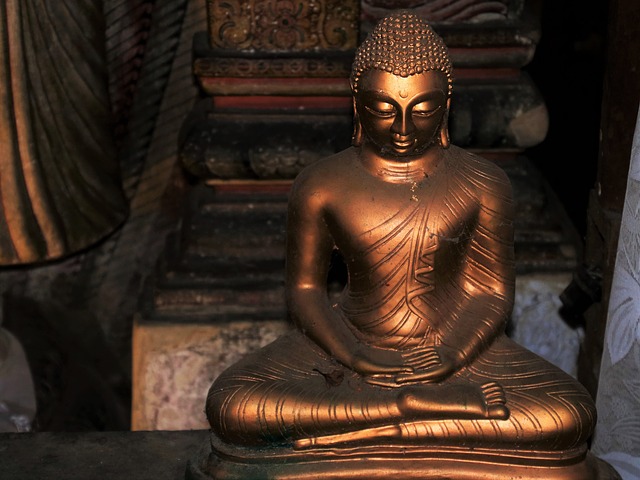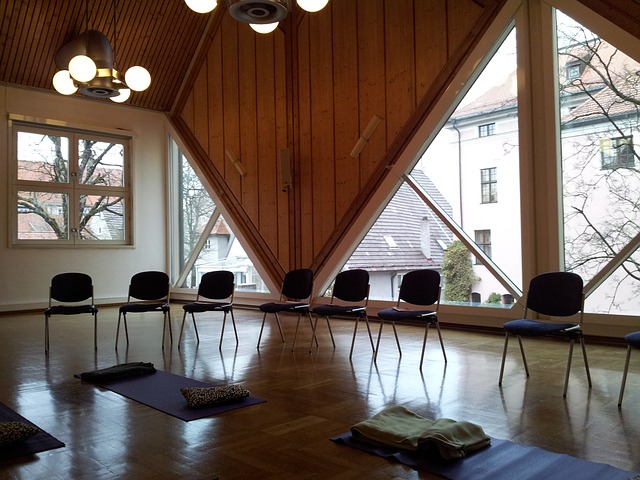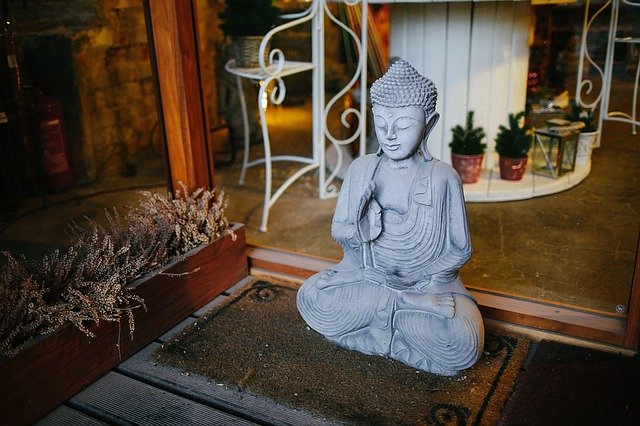
But first of all, why is it hard to maintain that bliss? Well, I’m sorry to say, but life kind of happens now and then. When you are on holiday or a retreat, you’ve got all the time in the world. No worries, just time for yourself, etc. After that, you come back in the real world and if you didn’t have a patterned practice yet, then it might be tough to start creating the habit of getting a regular yoga or meditation practice.
Meditation At Home

Create A Yoga And Meditation Space
You’ve probably read a lot of articles already about how to create your own meditation space, and it probably also mentioned a lot of products that you could buy. Well, a meditation space doesn’t have to cost a lot of money, or it doesn’t have to cost any money at all even.
 Choosing Your Space
Choosing Your Space
What you do need to have, is a space of which your family members or roommate will know that it is your space. You can also dedicate a corner in your room for meditation at well, although it’s not advisable to meditate in the room where you also sleep. This because of the connection that your brain will make by entering your bedroom. The moment your brain will see your bed, it will think that it’s time to go to bed. And chances will be that you fall asleep.
I’m not saying that it’s not possible at all, it’s just an ‘in case of emergency’ kind of thing. There are probably better places where you can meditate. And if you only have shared spaces, then try to get your roommates or family members to join you during your meditation practice! They might like it, and it gives you more dedication to your private practice.
Decorating Your Meditation Room or Space
To start meditation at home you’ve already got your dedicated space now. So, now it’s up to the decoration of it. And as I said, it doesn’t need to cost you anything at all. If you’ve read my article on how to make a DIY meditation kit, you already have a mini-shrine yourself.
If not, you can always make one right now ;).
The reason why you want to decorate your meditation room is pretty simple. You want to dedicate a room or space or a corner to the things that you want to do. For example, you’re not going to put a bed in your living 
So, for this matter, I always like to opt for a little shrine or altar. It sounds a bit weird and occult, but don’t worry, it has nothing to do with weird kind of rituals. An altar is just a table kind of piece that you will have where you can put on some things dedicated to your meditation practice. The things you put on this one are completely up to you. If you want you can put some relaxing pictures on it, crystals, incense, and many more things.
My little shrine has a Ganesha figure on it that I bought on my travels to India, an incense holder and rose quartz, and that’s it.
If you don’t have the money to buy a nice-looking table, don’t worry about that. It doesn’t have to be a high table, so if you have an old crate or box in your house, just use that one. You can put a nice table-cloth or something on it to mask the box a bit if it’s of the kind of material that isn’t pretty to look at.
Other things that you might want to add to your meditation space can range from about everything, you can put up some posters with inspirational quotes (which you can easily find on Pinterest), you can put up some Tibetan prayer flags, or whatever you like. The thing is that you just have to make sure that they are radiating calmness and tranquility to you, otherwise they lose their effect.
Another good thing to have at your meditation spot is some plants. It’s psychologically proven that plants in a room induce a calming effect and therefore they might be a great asset to have in your space. Even here it 
Alright, but now you’ve got everything ready to start your meditation practice at home. Now you’ve already got one excuse less on why you don’t start your meditation at home. Off to the next step!
Create An Intention
Sometimes it feels like I’m always talking about intention in a lot of my articles. But that’s actually where it starts as well. You’ve got to know why you want to meditate. If you don’t, there is no purpose in doing it. If you haven’t meditated or practiced yoga before, it might be best to take a class before you start your meditation practice at home, just to get a little feeling of what it means to you.

Some of these intentions can be:
- I need to find a way to relieve stress.
- I want to be more productive during the rest of the day.
- I want to be calmer.
- I need to think about a certain solution before I implement it.
- …
And there are many more! I even heard one time that one of my students started doing yoga because he got crazy about his mother in law. At first, going to a yoga class was an escape for him as he didn’t have to tag along with his wife to the weekly dinners, but at some point, he wanted to go anyway as her ways weren’t bothering him anymore.
Meditate a bit on your intentions ;), and write them down somewhere, just to make sure that now and then you got reminded of some of the reasons why you are doing meditation or yoga.
Build Up Your Meditation Practice
If you’ve ever heard about Vipassana, then you know that this kind of meditations is sitting silently for 8 hours straight. You might want to do this as well, but meditation is not a sprint, it is a marathon. So be sure that you build up your meditation practice very slowly.

It’s all about the succeeding mechanism. Everyone can sit silently for 10 minutes. So with every successful attempt that you’ve got, your self-esteem will also grow and chances are bigger than you might keep up with it! It’s like building furniture from Ikea. If you don’t succeed in it, you’ll get frustrated and you might even throw in the towel at some point, after hours of trying to create that piece of furniture that you love. Because of that, it might be that you won’t be going to Ikea that often anymore.
And the same goes for meditation, if you start by meditating for an hour, it might be that you get frustrated, which is the opposite effect of what you wanted to accomplish. Therefore, you’ll think that you are failing and meditation isn’t something for you. And you quit.
If you do want to do a longer meditation at the beginning of your meditation adventure, it might be wise to go for some guided meditations. They’re a good start to prepare yourself for going into the silence. Have a look at some of these apps if you don’t know where to start.
Make It a Habit
You might not like to hear this, but we are creatures of habit. And we have a lot of patterns that we repeat every single day. Think about it for a second. Don’t you go every morning to the same coffee shop where you have your favorite barista serving you? Or don’t you drive the same way home every single day when you are coming from work?

Well, I also have some good news, habits aren’t always a bad thing. You might think that it’s a safe way and that they will make you feel stuck, but it all depends on the habits that you created.
And you can even create new habits! All you’ve got to do is stick to something for 30 days, and after that, it gets easier to stick with it! Therefore, the first 4 weeks are the hardest. You don’t have an at-home meditation practice yet so the habit isn’t installed yet.
Try to dedicate some time, every two or three days in your schedule, just for meditation or yoga. And after a couple of weeks, you’ll see that it gets incorporated into your daily schedule!
And as I said before, try to involve some people around you. If you have someone that is joining you or supporting you, things will go a lot easier.
Conclusion
That’s about it on how to create your meditation practice, it’s quite easy if you are focused and have great support around you. You can even try to talk to your fellow meditation or yoga practitioners on how to create a home practice. There are also great apps out there in the play store and app store to aid you within your process.
If you have any more questions or nice ideas for a great meditation space, be sure to share them in the comment section below.
And for now,
Nama-stay wonderful!

 Choosing Your Space
Choosing Your Space



